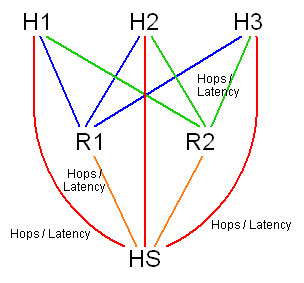- Internet standards are defined by Internet
Engineering Task Force (IETF) and published as RFCs (Request For Comments).
(a) When is the first RFC published? What is the topic? Who submitted it?
(b) How many RFCs have been published? When is the latest RFC published? What is the topic? Who submitted it?
(10 %)
- This problem requires you to run a traceroute from your computer
to some hosts and count number of hops required to reach the destination
and also record the latency to reach the destination. You can run "traceroute
using any of the following ways.
- from textbook companion website,
- run "tracert" on your Windows 95/98/NT/2000 machines, or
- if you have an account on bayou, you can run "traceroute" at prompt or /usr/sbin/traceroute if it can't be found.
- There is a web site called www.traceroute.org. This site provides links to hosts all over the world which provide interfaces to run traceroute from their local machines or routers. So you can run traceroute from Finland (EUNet) or Italy (IHnet).
- www.rice.edu - Rice University
- www.cisco.com - Cisco Systems, Inc.
- www.msu.ru - Moscow State University, Russia
- www.tau.ac.il - Tel Aviv University, Israel
- www.nus.edu.sg - National University of Singapore, Singapore
Thirdly, run traceroute from source (R1 and R2) to destination (H1, H2, and H3). Record number of hops and latency between source and destination. You should have 6 values for number of hops and 6 values for latency.
Fourthly, pick a home site. You can use your own PC (running Linux/BSD/Windows 95/98/NT/2000), bayou, or any host from www.traceroute.org (other than R1 and R2). We will label it as HS. Record host name or IP address of HS.
Fifthly, run traceroute from source (HS) to destination (R1, R2, H1, H2, and H3). Record number of hops and latency between source and destination. You should have 5 values for number of hops and 5 values for latency.
Now draw a graph similar to this one. Replace H1, H2, H3, R1, R2, and HS with their host names or IP addresses. Label each link with number of hops and latency.

Finally, calculate the total number of hops and latency between home site (HS) and hosts (H1, H2, and H3). Also, calculate the total number of hops and latency from home site (HS) via routers (R1 or R2) to hosts (H1, H2, and H3). You will have a table like this.
(10 %)Paths # of hopsLatency (msec)HS-H1 + HS-H2 + HS-H3 HS-R1-H1 + HS-R1-H2 + HS-R1-H3 HS-R2-H1 + HS-R2-H2 + HS-R2-H3